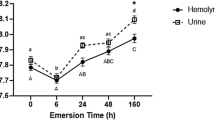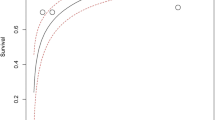Abstract
Adult Cancer magister make forays into hyposaline estuarine habitats during times of high food abundance. However, as weak osmoregulators, they are poorly equipped to deal with the concurrent demands of osmoregulation and digestion. Therefore, the potential interaction between nutritional status and feeding in a physiologically challenging environment was investigated. Changes in the proportion of crabs feeding, the amount of food consumed, the time spent feeding, and the efficiency with which a meal was consumed were examined in response to the length and severity of hyposaline exposure, and the duration of starvation. Reductions in the (a) number of animals feeding, (b) the amount of food consumed, and (c) the time spent feeding were observed in salinities where C. magister actively osmoregulates the concentration of its internal fluids. Although this reduction in feeding was likely a stress response, the crabs were able evaluate the level of salinity stress: there was a dose-dependent reduction in feeding, and they were able to discriminate between salinities separated by as little as 3.5‰. The likelihood that animals would feed in low salinity increased with starvation. Thus, the aversion to food uptake in physiologically stressful conditions may be overridden by the need to procure nutrients. In the natural environment, we suggest that C. magister are employing an ‘eat and run’ strategy, moving into the estuary, consuming a meal, and retreating to higher salinities to digest.







Similar content being viewed by others
References
Abrahams MV, Dill LM (1989) A determination of the energetic equivalence of the risk of predation. Ecology 70:999–1007
Ansell AD (1973) Changes in oxygen consumption, heart rate and ventilation accompanying starvation in the decapod crustacean Cancer pagurus. Neth J Sea Res 7:455–475
Barnes RSK (1967) Osmotic behaviour of a number of grapsoid crabs with respect to their differential penetration of an estuarine system. J Exp Biol 47:535
Beamish FWH (1974) Apparent specific dynamic action of largemouth bass, Micropterus salmoides. J Fish Res Board Can 31:1763–1769
Behmer ST, Belt CE, Shapiro MS (2005) Variable rewards and discrimination ability in an insect herbivore: what and how does a hungry locust learn? J Exp Biol 208:3463–3473
Clifford HC, Brick RW (1983) Nutritional physiology of the freshwater shrimp Macrobrachium rosenbergii (Deman).1. substrate metabolism in fasting juvenile shrimp. Comp Biochem Physiol Physiol 74:561–568
Cornell JC (1974) Reduction in water exchange rates in an osmoconforming crab. Am Zool 14:1259
Cromarty SI, Derby CD (1997) Multiple excitatory receptor types on individual olfactory neurons: implications for coding of mixtures in the spiny lobster. J Comp Physiol Sens Neural Behav Physiol 180:481–491
Curtis DL, McGaw IJ (2004) Feeding and digestion in low salinity: behavioural adaptations to avoid physiological multitasking in the Dungeness crab Cancer magister. Integr Comp Biol 44:686
Curtis DL, McGaw IJ (2008) A year in the life of a Dungeness crab: methodology for determining microhabitat conditions experienced by large decapod crustaceans in estuaries. J Zool 274:375–385
Curtis DL, McGaw IJ (2009) Respiratory and digestive responses of postprandial Dungeness crabs, Cancer magister, and blue crabs, Callinectes sapidus, during hyposaline exposure. J Comp Physiol B doi: 10.1007/s00360-009-0403-z
Curtis DL, Jensen EK, McGaw IJ (2007) Behavioral influences on the physiological responses of Cancer gracilis, the graceful crab, during hyposaline exposure. Biol Bull 212:222–231
Dufort CG, Jury SH, Newcomb JM, O’Grady DF, Watson WH (2001) Detection of salinity by the lobster, Homarus americanus. Biol Bull 201:424–434
Elliott CJH, Susswein AJ (2002) Comparative neuroethology of feeding control in molluscs. J Exp Biol 205:877–896
Elner RW, Hughes RN (1978) Energy maximization in diet of shore crab, Carcinus maenas. J Anim Ecol 47:103–116
Engelhardt FR, Dehnel PA (1973) Ionic regulation in Pacific edible crab, Cancer magister (Dana). Can J Zool Revue Canadienne De Zoologie 51:735–743
Florey E, Kriebel ME (1974) Effects of temperature, anoxia and sensory stimulation on heart-rate of unrestrained crabs. Comp Biochem Physiol 48:285–300
Guerin JL, Stickle WB (1992) Effects of salinity gradients on the tolerance and bioenergetics of juvenile blue crabs (Callinectes sapidus) from waters of different environmental salinities. Mar Biol 114:391–396
Guerin JL, Stickle WB (1997) Effect of salinity on survival and bioenergetics juvenile lesser blue crabs, Callinectes similis. Mar Biol 129:63–69
Gunderson DR, Armstrong DA, Shi YB, McConnaughey RA (1990) Patterns of estuarine use by juvenile English sole (Parophrys vetulus) and Dungeness crab (Cancer magister). Estuaries 13:59–71
Hallberg E, Johansson KUI, Wallen R (1997) Olfactory sensilla in crustaceans: morphology, sexual dimorphism, and distribution patterns. Int J Insect Morphol Embryol 26:173–180
Hoffman AA, Parsons PA (1993) Evolutionary genetics and environmental stress. Oxford University Press, New York
Holsman KK, McDonald PS, Armstrong DA (2006) Intertidal migration and habitat use by subadult Dungeness crab Cancer magister in a NE Pacific estuary. Mar Ecol Prog Ser 308:183–195
Houlihan DF, Waring CP, Mathers E, Gray C (1990) Protein synthesis and oxygen consumption of the shore crab Carcinus maenas after a meal. Physiol Zool 63:735–756
Hume RI, Berlind A (1976) Heart and scaphognathite rate changes in a euryhaline crab, Carcinus maenas, exposed to dilute environmental medium. Biol Bull 150:241–254
Juanes F (1992) Why do decapod crustaceans prefer small sized molluscan prey? Mar Ecol Prog Ser 87:239–249
Kinne O (1966) Physiological aspects of animal life in estuaries with special reference to salinity. Neth J Sea Res 3:222–244
Legeay A, Massabuau JC (2000) Effect of salinity on hypoxia tolerance of resting green crabs, Carcinus maenas, after feeding. Mar Biol 136:387–396
Lima SL, Dill LM (1990) Behavioral decisions made under the risk of predation: a review and prospectus. Can J Zool Revue Canadienne De Zoologie 68:619–640
Mayntz D, Raubenheimer D, Salomon M, Toft S, Simpson SJ (2005) Nutrient specific foraging in invertebrate predators. Science 307:111–113
McCue MD (2006) Specific dynamic action: a century of investigation. Comp Biochem Physiol Mol Integr Physiol 144:381–394
McGaw IJ (2006) Prioritization or summation of events? Cardiovascular physiology of postprandial Dungeness crabs in low salinity. Physiol Biochem Zool 79:169–177
McGaw IJ (2007) Gastric processing and evacuation during emersion in the red rock crab, Cancer productus. Mar Freshwat Behav Physiol 40:117–131
McGaw IJ, McMahon BR (1996) Cardiovascular responses resulting from variation in external salinity in the Dungeness crab, Cancer magister. Physiol Zool 69:1384–1401
McGaw IJ, Reiber CL (2000) Integrated physiological responses to feeding in the blue crab Callinectes sapidus. J Exp Biol 203:359–368
McGaw IJ, Reiber CL, Guadagnoli JA (1999) Behavioral physiology of four crab species in low salinity. Biol Bull 196:163–176
McKillup SC, McKillup RV (1994) The decision to feed by a scavenger in relation to the risks of predation and starvation. Oecologia 97:41–48
McKillup SC, McKillup RV (1995) The responses of intertidal scavengers to damaged conspecifics in the field. Mar Freshwat Behav Physiol 27:49–57
Moir F, Weissburg MJ (2009) Cautious cannibals: behavioral responses of juvenile and adult blue crabs to the odor of injured conspecifics. J Exp Mar Biol Ecol 369:87–92
Moore PG, Howarth J (1996) Foraging by marine scavengers: effects of relatedness, bait damage and hunger. J Sea Res 36:267–273
Normant M, Lamprecht I (2006) Does scope for growth change as a result of salinity stress in the amphipod Gammarus oceanicus? J Exp Mar Biol Ecol 334:158–163
Pan ZC, Ji X, Lu HL, Ma XM (2005) Metabolic response to feeding in the Chinese striped necked turtle, Ocadia sinensis. Comp Biochem Physiol Mol Integr Physiol 141:470–475
Pompilio L, Kacelnik A, Behmer ST (2006) State dependent learned valuation drives choice in an invertebrate. Science 311:1613–1615
Rovero F, Hughes RN, Chelazzi G (2000) When time is of the essence: choosing a currency for prey-handling costs. J Anim Ecol 69:683–689
Sanchez-Paz A, Garcia-Carreno F, Muhlia-Almazan A, Peregrino-Uriarte AB, Hernandez-Lopez J, Yepiz-Plascencia G (2006) Usage of energy reserves in crustaceans during starvation: status and future directions. Insect Biochem Mol Biol 36:241–249
Schmidt M (1989) The hair peg organs of the shore crab, Carcinus maenas (Crustacea, Decapoda): ultrastructure and functional properties of sensilla sensitive to changes in seawater concentration. Cell Tissue Res 257:609–621
Sears MA, Rittschof D (1991) Control of chemically stimulated feeding behavior in sand fiddler crabs Uca pugilator: evidence for hemolymph feeding inhibitory factor. J Chem Ecol 17:2337–2346
Sears MA, Rittschof D, Obrien T (1991) Eyestalk factor modulation of chemically stimulated feeding in sand fiddler crabs Uca pugilator (Bosc 1802). J Exp Mar Biol Ecol 152:1–13
Siebers D, Lucu C, Sperling KR, Eberlein K (1972) Kinetics of osmoregulation in crab Carcinus maenas. Mar Biol 17:291–303
Sims DW, Davies SJ (1994) Does specific dynamic action (SDA) regulate return of appetite in the lesser spotted dogfish, Scyliorhinus canicula. J Fish Biol 45:341–348
Spaargaren DH (1973) Effect of salinity and temperature on heart rate of osmoregulating and osmoconforming shrimps. Comp Biochem Physiol 45:773–786
Stenzler D, Atema J (1977) Alarm response of marine mud snail, Nassarius obsoletus: specificity and behavioral priority. J Chem Ecol 3:159–171
Stephens DW, Krebs JR (1986) Foraging theory. Princeton University Press, Princeton, NJ
Stevens BG, Armstrong DA (1984) Distribution, abundance, and growth of juvenile Dungeness Crabs, Cancer magister, in Grays Harbor estuary, Washington. Fish Bull 82:469–483
Stevens BG, Armstrong DA, Hoeman JC (1984) Diel activity of an estuarine population of Dungeness Crabs, Cancer magister, in relation to feeding and environmental factors. J Crust Biol 4:390–403
Sugarman PC, Pearson WH, Woodruff DL (1983) Salinity detection and associated behavior in the Dungeness Crab, Cancer magister. Estuaries 6:380–386
Taylor EW, Butler PJ, Alwassia A (1977) Effect of a decrease in salinity on respiration, osmoregulation and activity in shore crab, Carcinus maenas, at different acclimation temperatures. J Comp Physiol 119:155–170
Van Weel PB, Christofferson JP (1966) Electrophysiological studies on perception in antennulae of certain crabs. Physiol Zool 39:317–325
Wallace JC (1973) Feeding, starvation and metabolic rate in shore crab Carcinus maenas. Mar Biol 20:277–281
Wang T, Hung CCY, Randall DJ (2006) The comparative physiology of food deprivation: from feast to famine. Annu Rev Physiol 68:223–251
Webster SJ, Dill LM (2006) The energetic equivalence of changing salinity and temperature to juvenile salmon. Funct Ecol 20:621–629
Webster SJ, Dill LM (2007) Estimating the energetic cost of abiotic conditions using foraging behaviour. Evol Ecol Res 9:123–143
Wen XB, Chen LQ, Ku YM, Zhou KY (2006) Effect of feeding and lack of food on the growth, gross biochemical and fatty acid composition of juvenile crab, Eriocheir sinensis. Aquaculture 252:598–607
Acknowledgments
We wish to thank the director and staff of the Bamfield Marine Sciences Centre for use of facilities. This work was supported by an NSF grant (IBN #0313765) to IJM and an NSERC postgraduate scholarship to DLC.
Author information
Authors and Affiliations
Corresponding author
Additional information
Communicated by H. O. Pörtner.
Rights and permissions
About this article
Cite this article
Curtis, D.L., Vanier, C.H. & McGaw, I.J. The effects of starvation and acute low salinity exposure on food intake in the Dungeness crab, Cancer magister . Mar Biol 157, 603–612 (2010). https://doi.org/10.1007/s00227-009-1345-4
Received:
Accepted:
Published:
Issue Date:
DOI: https://doi.org/10.1007/s00227-009-1345-4




